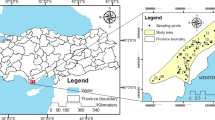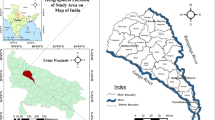Abstract
This study aims to investigate the groundwater salinity due to physical and chemical parameters using ANFIS-FCM and ANFIS-SCM methods in Azarshahr, Ajabshir and Maragheh plains situated in the Catchment Area of Urmia Lake, Iran. To this aim, 82 water samples were taken from wells and spring across the plains and chemically were analyzed in the laboratory. Descriptive statistics and correlation matrix of the studied parameters were obtained by SPSS software. Correlation matrix showed that four parameters including electrical conductivity (EC), dissolved oxygen (DO), total soluble solids (TDS) and pH had the highest correlations with salinity compared to the other parameters. Therefore, the mentioned parameters selected as inputs and salinity were the output according to the purpose of the study. After standardization, data were entered into the MATLAB environment and groundwater salinity was predicted using ANFIS-FCM and ANFIS-SCM methods. The models’ results showed that the estimated groundwater salinity for ANFIS-SCM model had very good accuracy and more correlation than the measured values. As a result, ANFIS-SCM intelligent method has been an effective, efficient and accurate method to estimate the parameters in the study area.










Similar content being viewed by others
References
Aghanabati A (2004) Geology of Iran. Publications of the Geological Survey of Iran, p 500
Akbarzadeh S, Arof AK, Ramesh S, Khanmirzaei MH, Nor RM (2014) Prediction of conductivity by adaptive neuro-fuzzy model. PLoS ONE 9(3):e92241
Arslan H (2012) Spatial and temporal mapping of groundwater salinity using ordinary kriging and indicator kriging: the case of Bafra Plain. Turk J Agric Water Manag 113(3):57–63
Asghari Moghadam L, Mohammad A (2004) Causes of salinity groundwater aquifers Shabestar Plains. J Agric Sci 13(2):69–78 (in Farsi)
Banerjee P, Singh VS, Chattopadhyay K, Chandra PC, Singh B (2011) Artificial neural network model as a potential alternative for groundwater salinity forecasting. J Hydrol 398(4):212–220
Beyki Hassan Abad H, Rostami F (2017) New method of leakage in water supply networks using ANFIS. In: First national conference on applied research in science and engineering
Bezdek JC (1973) Fuzzy mathematics in pattern classification. Cornell university, Ithaca
Chang LC, Chang FJ (2001) Intelligent control for modeling of real-time reservoir operation. Hydrogeol Process 15(9):1621–1634
Chiu SL (1994) Fuzzy model identification based on cluster estimation. J Intell Fuzzy Syst 2(3):267–278
Daneshvar Vousoughi F, Dinpashoh Y, Aalami MT, Jhajharia D (2012) Trend analysis of groundwater using non-parametric methods. J Stoch Environ Res Risk Assess 27(3):547–559
Demicco RV, Klir GJ (2004) Fuzzy logic in geology. Elsevier Academic Press, Amsterdam, p 346
Dolati Kordestani M, Nohegar A, Janizadeh S (2018) Assessment of some Artificial Intelligence (AI)-based models for groundwater quality prediction (case study: Garoo plain). Desert Ecosyst Eng J 6(17):27–42
Emamgholizadeh S, Moslemi Kh, Karami Gh (2014) Prediction the groundwater level of Bastam Plain (Iran) by artificial neural network (ANN) and adaptive neuro-fuzzy inference system (ANFIS). Eur Water Resour Assoc EWRA) 28(15):5433–5446
Gholami R, Moradzadeh A, Maleki S, Amiri S, Hanachi J (2014) Applications of artificial intelligence methods in prediction of permeability in hydrocarbon reservoirs. J Pet Sci Eng 122:643–656
Hasebe M, Nagayama Y (2002) Reservoir operation using the neural network and fuzzy systems for dam control and operation support. Adv Eng Softw 33:245–260
Iran Resource Management Company (2011) Deputy for basic studies and water basin management of water resources basic studies office, country aquifer information, Lake Urmia Basin, West Azerbaijan Province.
Jalalkamali A, Jalalkamali N (2018) Adaptive network- based fuzzy inference system-genetic algorithm models for prediction groundwater quality indices: a GIS-based analysis. J AI Data Min 6(2):439–445
Jang JSR (1993) ANFIS: adaptive-network-based fuzzy inference system. IEEE Trans Syst Man Cybern 23(3):665–685
Jang JSR, Sun CT, Mizutani E (1997) Neuro-fuzzy and soft computing a computional approach to learning and machine intelligence. Prentice Hall, NJ
Jayalakshmi T, Santhakumaran A (2011) Statistical normalization and back propagation for classification. Int J Comput Theory Eng 3(1):1793–8201
Khosravi Kh, Panahi M, Bui DT (2018) Spatial prediction of groundwater spring potential mapping based on an adaptive neuro-fuzzy inference system and metaheuristic optimization. Hydrol Earth Syst Sci 22:4771–4792
Kosko B (1992) Neural networks and fuzzy systems, a dynamical approach to machine intelligence. Prentice Hall, Englewood Cliffs, p 449
Lu RS, Lo SL (2002) Diagnosing reservoir water quality using self-organizing maps and fuzzy theory. Water Res 36:2265–2274
Mozaffarizadeh J, Sajjadi Z (2012) Investigating the causes of salinity and infiltration of saline water from Dalaki and Hilleh rivers into Borazjan aquifer. J Water Resour Eng 16(6):69–78
Nava P, Taylor J (1996) The optimization of neural network performance through incorporation of fuzzy theory, In: 11th Conference on systems engineering, pp 897–901
Nayak PC, Sudheer KP, Rangan DM, Ramasastri KS (2004) A neuro-fuzzy computing technique for modeling hydrological time series. J Hydrol 291:52–66
Ponnambalam K, Karray F, Mousavi SJ (2003) Minimizing variance of reservoir systems operations benefits using soft computing tools. Fuzzy Sets Syst 139:451–461
Saeedi Razavi B, Arab A (2019) Groundwater level forecasting using fuzzy logic, neural network and time series models. Hydrogeol J Tabriz Univ Iran 3(2):69–81
Shahrabi M (1972) Description of geological map of Urmia. Geological Survey of Iran, p 81
Srinivasan K, Fisher D (1995) Machine learning approaches to estimating software development effort. IEEE Trans Softw Eng 21(2):126–137
Todd D, Mays L (2005) Groundwater hydrogeology. John Wiley and Sons, New York
Tutmez B, Hatipoglu Z, Kaymak U (2006) Modelling electrical conductivity of groundwater using an adaptive neuro-fuzzy inference system. Comput Geosci 32(2006):421–433
Velayati S (2011) The effects and consequences of excessive extraction of ground water aquifer of Mashhad plain, with emphasis on changes in Ec of water. J Geogr Reg Dev 15(2):21–37 (in Farsi)
Zadeh LA (2006) Fuzzy Logic Toolbox For Use with MATLAB. Math Works Inc. Berkeley CA
Acknowledgements
The authors thank the sincere cooperation of the Geological Survey of Iran to provide some of the required information.
Author information
Authors and Affiliations
Corresponding author
Additional information
Publisher's Note
Springer Nature remains neutral with regard to jurisdictional claims in published maps and institutional affiliations.
Rights and permissions
About this article
Cite this article
Nazari, H., Taghavi, B. & Hajizadeh, F. Groundwater salinity prediction using adaptive neuro-fuzzy inference system methods: a case study in Azarshahr, Ajabshir and Maragheh plains, Iran. Environ Earth Sci 80, 152 (2021). https://doi.org/10.1007/s12665-021-09455-3
Received:
Accepted:
Published:
DOI: https://doi.org/10.1007/s12665-021-09455-3




